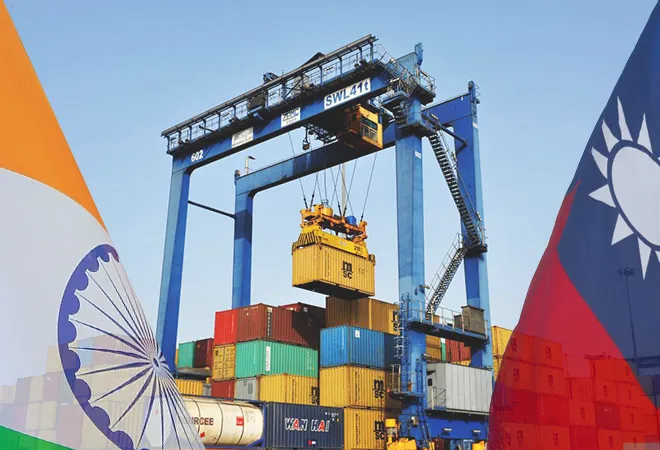
High potential in bilateral trade
Since the early 1990s, after the initiation of the Indian government’s “Look East Policy”, Taiwan and India started approaching each other with a long-term vision of deeper bilateral cooperation. In July 2011, the two countries
signed two agreements on double taxation avoidance and customs mutual assistance that further enhanced their economic and trade relationship.
In the recent past, the relationship gained substantial momentum after Taiwan decided to initiate a “New Southbound Policy”, which synchronised well with India’s latest “Act East Initiative”. Deepening of engagement resulted in the signing and subsequent upgrade of
bilateral investment agreements, in 2002 and 2018.
Continuing with the momentum, India and Taiwan
started negotiations for a free trade agreement (FTA) in December 2021. This is a significant step towards a deeper and broad-based bilateral economic engagement. From India’s side, this aligns with the country’s present eagerness to expand trade through various bilateral and multilateral initiatives.
Bilateral trade between India and Taiwan
grew from US$2 billion in 2006 to US$5.7 billion in 2020, registering a 185 percent growth. FDI (foreign direct investment) inflows from Taiwan increased almost 10 times between 2017–18 and 2018–19. Cumulative FDI inflows from Taiwan to India are valued at US$698.6 million in the period between April 2000 and December 2021.
| TABLE 1: Growth rates and share in India-Taiwan bilateral trade in April-March (in US$ million) |
| |
Apr-Mar 2021 |
Apr-Mar 2022 |
% growth |
% share in total trade |
| Indian export to Taiwan |
1620.15 |
2756.70 |
70.15 |
0.65 |
| Indian import from Taiwan |
4036.75 |
6233.39 |
54.42 |
1.02 |
| Source: Foreign Trade Performance Analysis, Ministry of Commerce & Industry, Government of India |
The latest monthly trade data also demonstrate healthy growth rates in Indian exports to and imports from Taiwan (
Table 1). However, the volume of bilateral trade remains underwhelming, given the potential. This is evident from the minuscule exports and imports share.
On the investment front, around
106 Taiwanese companies—with a total investment (actual and proposed) of about US$1.5 billion—were operating in India in various sectors including information and communication technology, medical devices, automobile components, machinery, steel, electronics, construction, engineering, and financial services, by the end of 2018.
In the last few years, India has been actively promoting cooperation with Taiwan in trade, investment, tourism, culture, education, and people-to-people exchanges. Both the countries have also constituted teams for the expansion of fruitful collaboration in education and skill development.
Indian Space Research Organisation (ISRO) and the Indian Institute of Space Science and Technology (IISST) are already collaborating with Taiwan’s National Space Organisation
on different projects. Another possible area of cooperation exists in green energy. India is an energy-deficient country but needs to make the transition from fossil-fuel-based energy to renewable green energy. On the other hand, Taiwan is one of the major Asian players in green energy and may turn into a game-changer for India in this transitory phase.
Indian wish for a semiconductor hub
Taiwan’s main strength is in the machinery and electrical equipment sector, as is evident from
Table 2. India’s current focus is on utilising this Taiwanese advantage. The FTA talks currently are strongly pivoted around the proposal to build a semiconductor manufacturing facility in India.
The Indian government has reportedly proposed several sites for the hub and negotiations are on to rope in one of Taiwan’s leading semiconductor manufacturers. Names of companies like Taiwan Semiconductor Manufacturing Company (TSMC) and United Microelectronics Corporation (UMC) have come up in media reports as possible candidates for implementing this mega project.
If implemented, India will be the second hub of Taiwanese semiconductor manufacturers after the USA. However, the choice of location may be a difficult one as semiconductor production entails necessities like a pollution-free environment, an uninterrupted power supply, and the constant availability of a large amount of water.
| TABLE 2: Major trade product groups of Taiwan |
| Major exports 2021 |
% of total |
Major imports 2021 |
% of total |
| Machinery & electrical equipment |
61.9 |
Machineries & electrical equipment |
37.7 |
| Basic metals & articles |
8.2 |
Minerals |
9.7 |
| Plastic & rubber articles |
6.7 |
Chemicals |
7.5 |
| Chemicals |
5.2 |
Basic metals & articles |
5.6 |
| Source: Country Reports, Economist Intelligence Unit (EIU) |
As the global shortage of semiconductor chips continues and demand by Indian auto manufacturers and tech companies rises, an Indian manufacturing hub created by a Taiwanese company seems to be a win-win proposition for both countries. However, it is easier said than done. Production of semiconductors is a
complicated process where the manufacturer uses numerous components from hundreds of other firms. Setting up a hub in India implies that companies like TSMC and UMC have to convince these firms to set up their production facilities in India.
The China factor
China remains Taiwan’s biggest export destination and the largest importing source (
Table 3). Taiwan has a shortage of labour, particularly skilled labour. This prompted the country to establish many manufacturing facilities in China. That contributes to Taiwanese import value from China. In recent times, however, China has mounted huge political and military pressure on the island nation by
increasing air incursions and creating tension in the Taiwan Strait. Taiwan’s decision to institute a semiconductor hub in the USA, in a way, is a result of that.
| TABLE 3: Major export destinations and import sources of Taiwan |
| Leading markets 2021 |
% of total |
Leading suppliers 2021 |
% of total |
| China |
28.2 |
China |
21.6 |
| US |
14.7 |
Japan |
14.7 |
| Hong Kong |
14.1 |
US |
10.3 |
| Singapore |
5.8 |
South Korea |
8 |
| Source: Country Reports, Economist Intelligence Unit (EIU) |
India, on the other hand, is also at the receiving end of
Chinese aggression at the line of actual control (LAC) the in Ladakh region. So, there is a common interest for both the countries to build up a larger cooperative framework.
India’s appetite for semiconductors is also rapidly increasing—estimated to touch US$100 billion by 2025 from the current level of US$2 billion. The Indian government also announced an outlay of INR 76,000 crore (around US$10 billion), under its production linked incentive (PLI) scheme, separately for the development of a semiconductor and display manufacturing electronics ecosystem.
Therefore, creating an economic and cooperative framework under an FTA is likely to benefit both countries. Technically speaking, India and Taiwan signing an FTA and subsequently erecting an economic and technological cooperation framework, in no way, violates adherence to the “One China Policy” as exercised by the Chinese government.
In the wake of the Russia-Ukraine war, there is a growing apprehension of a future Chinese invasion of Taiwan. However,
President Biden’s latest assertion—that the USA will militarily intervene if China attempts to invade Taiwan—puts those speculations at rest for the time being. It is very unlikely that the Ukraine war would present such an opportunity to China.
China reaped immense benefits from Taiwanese investments on its soil in the past. Now, when Taiwan is more than willing to pull out and reduce its dependence on China, India should try its best to benefit from this phenomenon. An India–Taiwan FTA would be the first step towards that.
The views expressed above belong to the author(s). ORF research and analyses now available on Telegram! Click here to access our curated content — blogs, longforms and interviews.




 PREV
PREV


